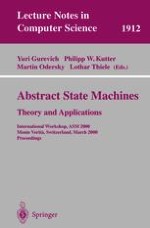The ASM 2000 workshop was held in the conference center of the Swiss Federal Institute of Technology (ETH) at Monte Verit a, Canton Ticino, March 19-24, 2000. The ASM formalism was proposed together with the thesis that it is suitable to model arbitrary computer systems on arbitrary abstraction levels. ASMs have been successfully used to analyze and specify various hardware and software systems including numerous computer languages. The aim of the workshop was to bring together domain-experts, using ASMs as a practical speci cation method, and theorists working with ASMs and related methods. In addition the workshop served as a forum on theoretical and practical topics that relate to ASMs in a broad sense. Three tutorials including hands-on experience with tools were organized by U. Gl¨asser and G. del Castillo (on the topic \Specifying Concurrent Systems with ASMs"), H. Russ ¨ and N. Shankar (on the topic \A Tutorial Introduction to PVS"), M. Anlau , P.W. Kutter, and A. Pierantonio (on the topic \Developing Domain Speci c Languages"). In response to the organization committee’s call for papers, 30 papers were submitted, each of which was independently reviewed by four members of the program committee. This volume presents a selection of 12 of the refereed papers and two reports on industrial ASM application at Siemens AG and Microsoft Research, together with contributions based on the invited talks given by A.
